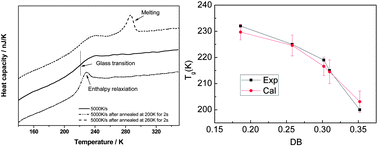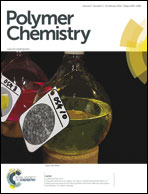The relationship between the degree of branching and glass transition temperature of branched polyethylene: experiment and simulation†
Abstract
Polyethylene (PE) samples with similar number-averaged molecular weight but various degrees of branching (DBs) were synthesized by means of ethylene coordination polymerization catalyzed by an amine–imine nickel catalyst or α-diimine palladium catalyst, respectively. Different from the conventional DB of branched PE, here we calculated the DB according to the equation proposed by Hawker et al., i.e., DB is the ratio of the number of dendritic units (–CHCH2–) and terminal units (–CH2CH3) to the number of all units (dendritic, terminal and linear units (–CH2CH2–)) in the PE backbone and branches. The glass transition temperature (Tg) of the prepared PE samples was studied by dynamic mechanical analysis (DMA), differential scanning calorimetry (DSC) and ultra-fast differential scanning calorimetry (UF-DSC). The DSC data show that the crystallization and the glass transition processes of branched PE samples are correlated with each other, and both the melting temperature and the glass transition temperature decreased with increasing DB. The UF-DSC results show that the crystallization of the PE samples with high DB can be prevented when the cooling rate in calorimetry is high enough. For example, the crystallization peak of branched PE with DB = 0.310 totally disappears when the cooling rate in calorimetry reaches more than 5000 K s−1 and only a glass transition takes place at −51.3 °C. Furthermore, correlation between the glass transition temperature and the DB of branched PE has been well established by atomistic molecular dynamics (MD) simulations. The values of MD-determined Tg are in good agreement with experimental results. The difference of free volume in PE systems with different DBs, which is reflected by the calculated radial distribution function, is the reason for the observed change of Tg on DB.


 Please wait while we load your content...
Please wait while we load your content...